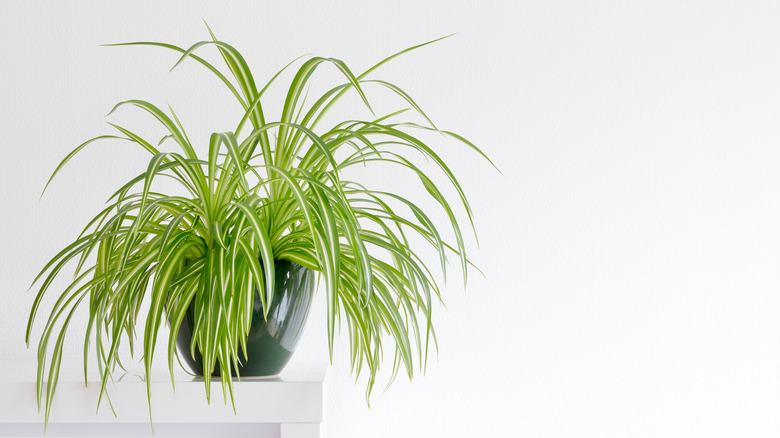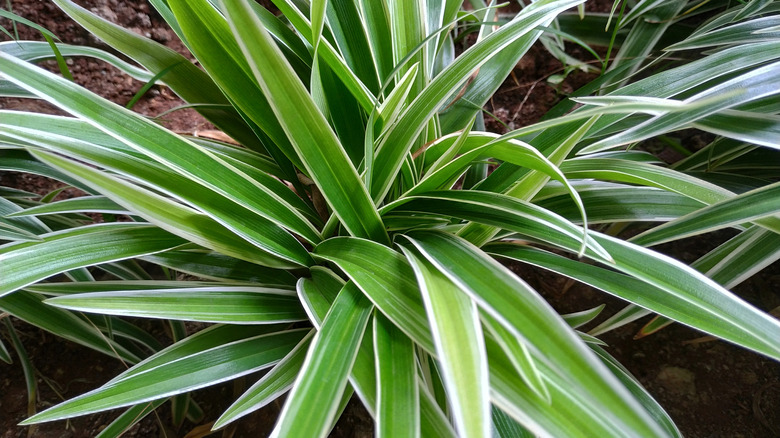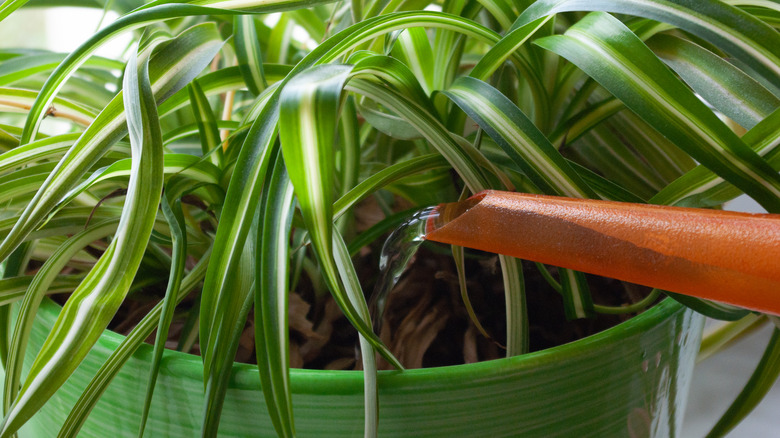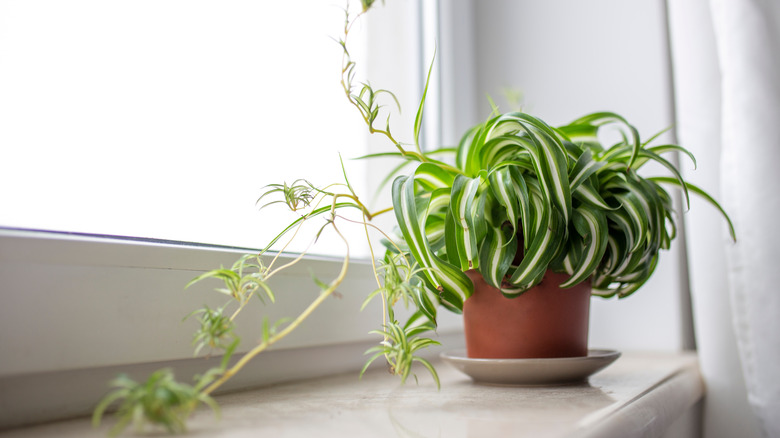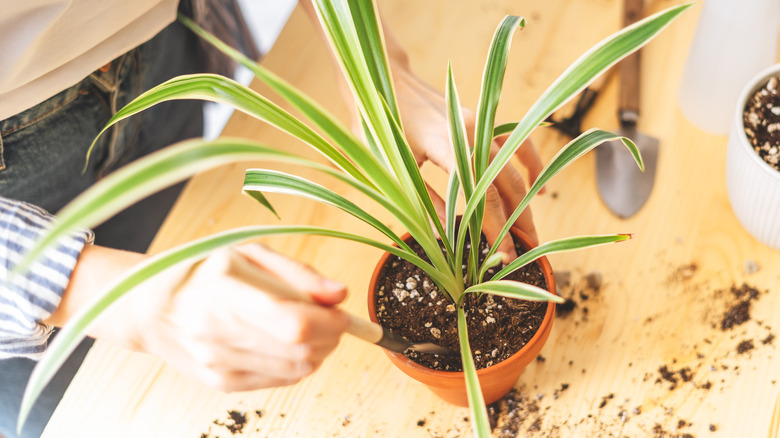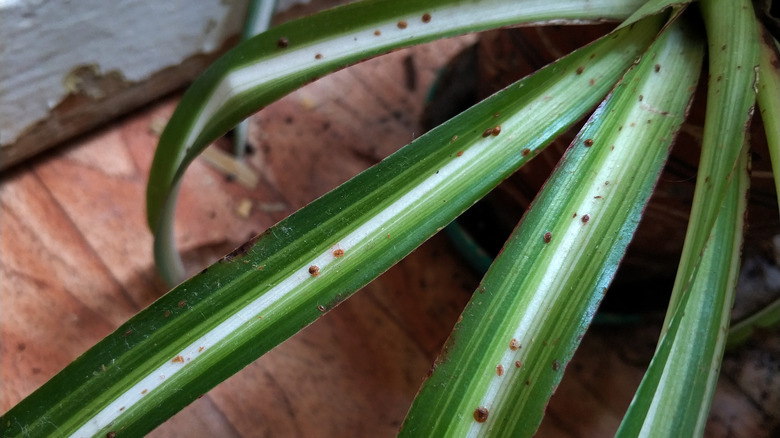Spider Plants: Everything You Should Know Before Planting
Spider plants (Chlorophytum comosum) do not really look like spiders, but some varieties of these plants feature long, thin offshoots that might make you think of spindly spider legs. Apartment Therapy notes that spider plants are often called airplane plants, spider ivy, and ribbon plants. The leaves of spider plants are long and thin, and often resemble blades of thick grass. Cream-colored or white stripes are prominent on the leaves of many variations.
Additionally, the long, skinny offshoots on mature spider plants produce small white flowers. When the flowers fall off, a spiderette, which looks like a miniature version of the plant, replaces them. The mini plants attached to the ends of the lengthy stems make the plants ideal for hanging, not to mention viewing. According to The Spruce, these plants tend to grow quickly in the right conditions, and if they are hanging in a spacious area, the leaves can grow as long as one and a half feet long.
How to grow spider plants
Because these plants are relatively easy to grow and care for, spider plants are popular houseplants. Even if you do not think you have a green thumb, you should try these hardy plants because they can withstand a little neglect, as Smart Garden Guides points out. Spider plants do not mind cramped spaces, as long as they get enough water and light. Speaking of light, they enjoy plenty of indirect light, but they can also grow in low light. That being said, spider plants grown in low-light conditions will not grow as fast as plants kept in lighter areas. They do not even mind humid conditions, which means you can keep one in your bathroom without much worry, according to Apartment Therapy. Since spider plants like mild temperatures and moderate lighting, you can place them in just about any room in the house, as noted by HGTV.
When it comes to propagating spider plants, cultivating them is easier than you might think. The plant makes it easy because the spiderettes hanging from the stems are actually small spider plants that are ready to be repotted. All you need to do is remove one of them and place it on top of moist potting soil, where it will soon grow roots (via Better Homes & Gardens).
How to care for spider plants
When it comes to watering spider plants, you will want to keep the soil barely moist, and water about once a week during the spring and summer. During the winter, it is fine to let the soil dry out a little between waterings. HGTV notes that some spider plants do not tolerate the fluoride in tap water well, so you'll want to keep an eye out for symptoms of fluoride toxicity. They include dead or brown areas on the tips of the leaves, according to SF Gate. If you notice these symptoms, try watering your plant with distilled water or rain water to see if these conditions improve.
If you live in USDA zones 9 through 11, you can grow spider plants outdoors. If you do decide to put your spider plant outside, SF Gate recommends putting it where it gets plenty of indirect light. Spider plants can stay outside in colder weather, but The Spruce advises bringing them inside before the first frost. When it comes to fertilization, you fertilize spider plants once a month in the spring and summer with a water-soluble fertilizer, according to Better Homes & Gardens. While brown tips on leaves can indicate a sensitivity to fluoride in tap water, they can also mean over-fertilization. If you have been using distilled water or rain water to water your plant and still notice brown leaves, Smart Garden Guide suggests reducing how often you fertilize it.
Varieties of spider plants
The varieties of spider plant include Chlorophytum comosum variegatum, which features thin, cream-colored stripes along the outdoor edges of the leaves; the long stems that produce spiderettes are green. Another type of spider plant is the Chlorophytum comosum vittatum, which has a cream stripe down the center of the leaves, and its spiderette-bearing stems are more of a white or cream color (via The Spruce).
Chlorophytum comosum bonnie varieties are smaller and denser than the other kinds of spider plants, and the leaves are also shorter and curlier than the other types of plants. Additionally, Bonnie leaves feature cream stripes down the center, making them look similar to the vittatum variety. The small flowers on the bonnie breed are yellow as opposed to white or cream. According to Plant Care Today, if you keep a bonnie variety indoors, it may not bloom at all, which makes it ideal for smaller spaces.
Are spider plants toxic?
Spider plants are not toxic to cats or dogs, according to the ASPCA. However, if your furry friends end up chewing on some of the leaves of spider plants, that could cause them to have an upset stomach. Dogs cannot digest plants, as noted by Plant Care Today, and will generally only eat plants when they are feeling ill. Ingesting parts of the spider plant might make dogs vomit or cause a bout of diarrhea.
Cats could suffer similar symptoms after eating the leaves of spider plants. Interestingly, your cat might become obsessed with your spider plant as well, acting much like the way it does when it is around catnip. The Nest explains that ingesting spider plant leaves could result in your cat experiencing mild hallucinations. While this is typically harmless, it is something to be aware of if your cat likes to nibble on plants.
How to repot spider plants
When it comes to repotting a spider plant, you should not run into too many problems. Interestingly, spider plants do not seem to mind when they are slightly pot bound, meaning you do not have to repot them as much as you would other houseplants. That being said, when you notice that water is not draining out of the bottom of the pot because the roots are restricted, it is time to transfer the plant to a new pot.
When you do transplant the spider plant, make sure to move it into to a pot that is about two inches larger than the one it is currently in. The pot you use should also have plenty of drainage holes. When repotting, shake as much of the old soil from the roots as you can. My Domaine recommends pruning about one-third of the roots away at this point.
Troubleshooting spider plant pests
The good news about spider plants is the fact that they do not suffer from many conditions or diseases that are hard to remedy. Better Homes & Gardens notes that the bigger problems with these plants are spider mites, aphids, and whiteflies. If you see these pests on the leaves of the plants, you might consider moving them to a brighter location. You can wash the bugs off of the leaves of spider plants by spraying them with water either in the shower or outside.
If you notice a sticky substance on the leaves of your spider plant, you may have a scale infestation. Scale is nearly impossible to see, but sometimes you will notice a brown patch underneath the leaves. In contrast, mealybugs leave white cotton patches on leaves. One way to rid the plants of these pests is to apply a cotton swab dipped in alcohol to the sticky areas. You can also apply neem oil to the affected areas. Sometimes, a fresh pot of soil along with treatment is effective (via Gardening Know How).
